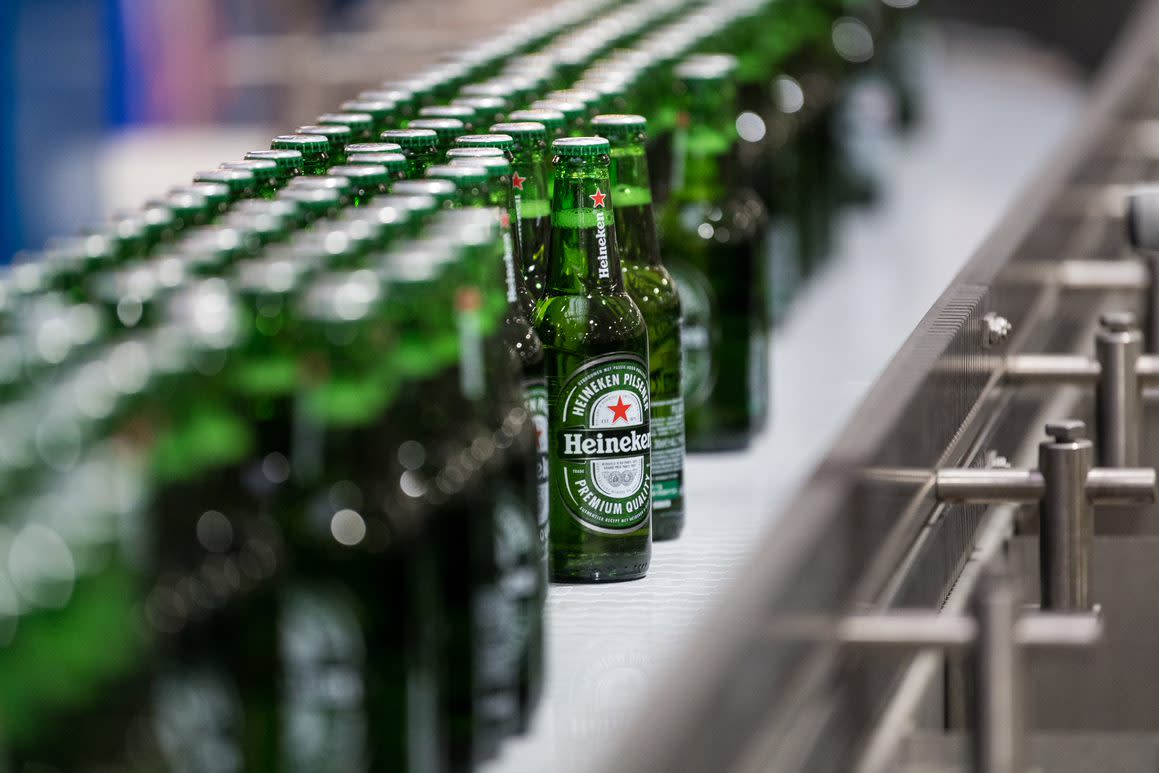Heineken reported better-than-expected underlying net revenue of €7.8bn in the first quarter, up 0.9% on an organic basis. Growth was driven entirely by higher average prices, which offset a 2.4% decline in volumes.
Premium beer volumes grew at a faster pace of 1.8%, led by Vietnam and India. Heineken was the standout brand with total volumes up 4.6%, including double-digit growth in 25 markets.
Heineken called out uncertainties related to the impact of recent tariffs. Changes in exchange rates are set to be a headwind to profit this year but are expected to be more than offset by €0.4bn of cost savings.
The full-year outlook has been reiterated, with underlying operating profit expected to grow by 4-8% (market consensus: +6%).
Around €87mn of share were purchased in the period, with the remainder of the €750mn share buyback programme set to be completed by 30 January 2026.
The shares rose 2.4% in early trading.
Our view
Heineken got off to a solid start in 2025, with revenue growing slightly ahead of market forecasts. All regions performed well in the period, but currency headwinds and tariff uncertainties are areas to watch.
The group owns high-end favourites such as Heineken, Birra Moretti, Old Mout Cider and many more. The ongoing shift by consumers towards these more premium brands remains strong and should help to boost profitability going forward.
The Asia Pacific (APAC) region is a key market for the group. Vietnam is one area of opportunity where the group is successfully navigating emerging competition and new regulations. They have seen strong growth in India too, where Heineken owns the country’s leading brand Kingfisher.
However, APAC has some heavy-lifting to do if it’s to offset the sluggish growth being seen in the more mature American and European markets. Currency weakness in developing regions is one particular risk that investors should pay close attention too.
Encouragingly, non-alcoholic offerings have continued to show positive momentum. Headlined by the leading Heineken 0.0 brand, the group has a growing portfolio of non-alcoholic beers and ciders, and holds the number-one spot in many of its markets. But it’s a small part of the pie for now.
The eB2B platform is another shining light. This makes it easier for business customers, like bars and pubs, to order in their selected drinks - while simultaneously cutting out sales reps to improve margins.
Heineken’s aiming to drive significant efficiency gains this year, targeting savings of €0.4bn. That should free up cash to deploy into other areas of the business, with a material step up in its marketing efforts being top of the agenda.
Tariffs look set to have limited direct impact on the group, given that over 95% of its volumes are brewed in the same region they’re sold. However, if US-led tariff policies lead to a global economic slowdown, that’s likely to weigh on consumer confidence and demand.
The ratio of net debt to cash profits (EBITDA) sat at 2.2 times last we heard, just inside management's long-run target of under 2.5 times. There’s scope for further progress if this year’s guidance is delivered.
All in, we’re pleased by the improved operational performance and the positive effect it’s having on profitability. Valuations across the sector have been put under pressure by demand concerns and Heineken is no exception. We see scope for the valuation to close the gap with the long-term average. However, the macroeconomic picture remains uncertain which adds risk.
Environmental, social and governance (ESG) risk
The food and beverage industry tends to be medium-risk in terms of ESG though some segments like agriculture, tobacco and spirits fall into the high-risk category. Product governance is a key risk industry-wide, especially in areas with strict quality and safety requirements. Labour relations and supply chain management are also industry-wide risks, with other issues varying by sub-sector.
According to Sustainalytics, Heineken’s management of ESG risks is strong.
Heineken aims to reach net zero in scope 1 and 2 emissions, as well as reduce scope 3 emissions by 21% by 2030. Net zero across the entire value chain is expected by 2040. Investors should keep in mind that product consistency and quality is a major selling point for Heineken. Any slip-up on this front could lead to brand damage and the potential to lose market share and revenue.
Heineken key facts
All ratios are sourced from LSEG Datastream, based on previous day’s closing values. Please remember yields are variable and not a reliable indicator of future income. Keep in mind key figures shouldn’t be looked at on their own – it’s important to understand the big picture.
This article is not advice or a recommendation to buy, sell or hold any investment.No view is given on the present or future value or price of any investment, and investors should form their own view on any proposed investment.This article has not been prepared in accordance with legal requirements designed to promote the independence of investment research and is considered a marketing communication.Non - independent research is not subject to FCA rules prohibiting dealing ahead of research, however HL has put controls in place(including dealing restrictions, physical and information barriers) to manage potential conflicts of interest presented by such dealing.Please see our full non - independent research disclosure for more information.


